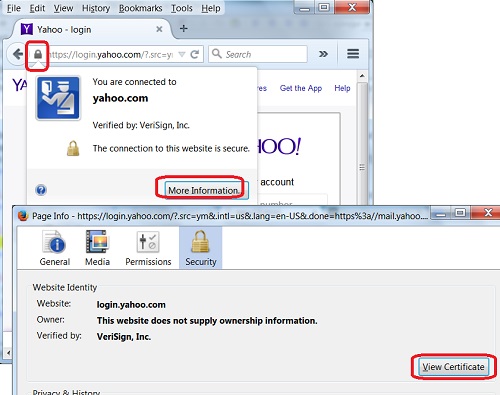PKI Tutorials - Herong's Tutorial Examples - v2.20, by Dr. Herong Yang
Outdated: Viewing Server Certificate in Firefox 35
This section provides a tutorial example on how to view certificate when visiting an 'https' Website in Mozilla Firefox.
When you visit a "https" Web server, it will send its certificate to your browser. Server's certificate is needed by the browser for these 2 tasks:
- Your browser must validate the certificate to determine that the Website can be trusted or not before doing any further communications.
- Your browser must use the public key in the certificate to help secure the communication messages sent and received.
Normally, your browser will do these 2 tasks automatically without your interaction. You don't need to know where is the server certificate and what's in the certificate.
But since I am interested to learn more about "https" communication, I want to see the server certificate. Here is what did on Mozilla Firefox to see details of the server certificate.
1. Run Mozilla Firefox and go to https://login.yahoo.com and wait for the log in page to be displayed.
2. Click the lock icon at right side of the web address. The page security information message box shows up:
You are connected to yahoo.com Verified by: VeriSign, Inc. The connection to this website is secure.
3. Click the "More Information..." button on the message box. The Page Info dialog box shows up displaying the "Security" tab.
4. Click the "View Certificate" button. The Certificate Viewer dialog box shows up.
Cool. Now I see a real server certificate for commercial uses. The picture below shows you steps to see the certificate:

Table of Contents
Introduction of PKI (Public Key Infrastructure)
Introduction of HTTPS (Hypertext Transfer Protocol Secure)
Using HTTPS with Google Chrome
Using HTTPS with Mozilla Firefox
HTTPS with IE (Internet Explorer)
Android and Server Certificate
Windows Certificate Stores and Console
RDP (Remote Desktop Protocol) and Server Certificate
macOS Certificate Stores and Keychain Access
Perl Scripts Communicating with HTTPS Servers
PHP Scripts Communicating with HTTPS Servers
Java Programs Communicating with HTTPS Servers
.NET Programs Communicating with HTTPS Servers
CAcert.org - Root CA Offering Free Certificates
PKI CA Administration - Issuing Certificates
Comodo Free Personal Certificate
Digital Signature - Microsoft Word
Digital Signature - OpenOffice.org 3
PKI (Public Key Infrastructure) Terminology
Outdated: Viewing Server Certificate in Chrome 40
►Outdated: Viewing Server Certificate in Firefox 35
Outdated: Viewing Pre-Installed Certificates in Firefox 35
Outdated: Firefox 35 Displaying Certificate Error Page
Outdated: Adding Security Exception in Firefox 35
Outdated: Windows XP Component "Update Root Certificates"
Outdated: Creating Certificates Console on Windows XP
Outdated: Applying Digital Signatures with Word 2007
OutDated: Creating a Digital ID and Sign Word Documents
OUtdated: Viewing Digital ID Created by MS Word
Outdated: Obtaining a Trial Digital ID from ARX CoSign
Outdated: Viewing Digital ID Obtained from ARX CoSign
Outdated: Windows XP Component - Removing "Update Root Certificates"
Outdated: IE 8 Displaying Certificate Error Page
Outdated: IE 8 Displaying Certificate Error Icon
Outdated: Viewing Certificate Path Validation Error in IE 8